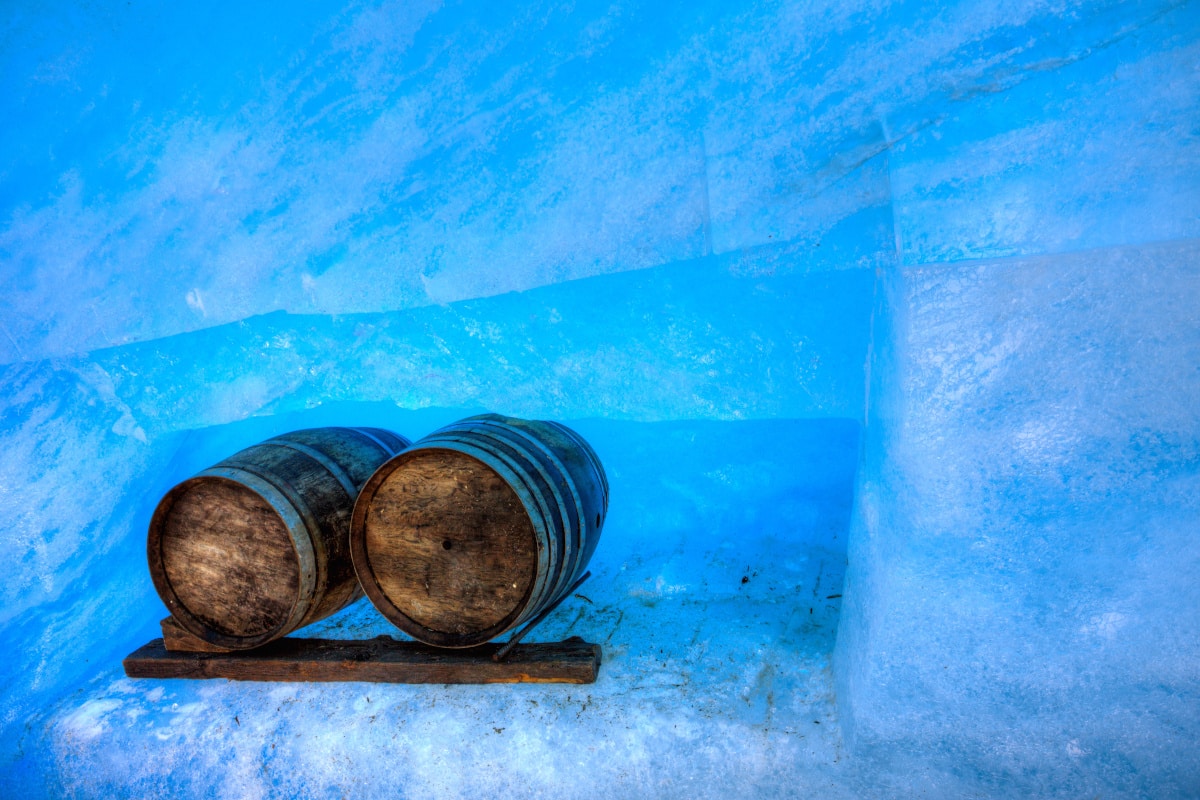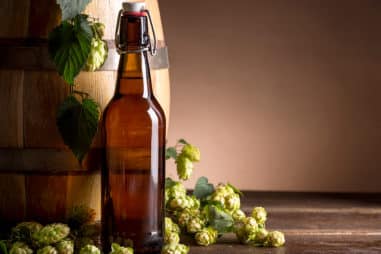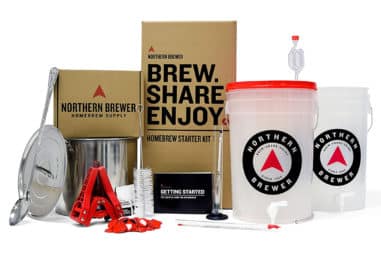Cold Beer Fermentation, put simply, is just keeping things cool — work the product nice and slow. It’s all about giving your beer the time it needs to mature into a fine specimen — a masterpiece, if you will. Rome was not built in a day, or so they say.
This post should give you all you need to know, read on to cold ferment like a pro … even if you brew in a place without snow.
Can Fermentation Happen in Cold?
Fermentation can definitely occur in cold places, including your home in winter. This was how lager yeast had been discovered, and how it ultimately started the proliferation of lager beers.
Yeasts, and life in general, evolved to be capable of conducting their business even in the most inhospitable environments.
Does Cold Temperature Affect Fermentation?
Cold, from a rough physics definition, is the absence of heat energy. Without energy, the processes that motivate life cannot proceed in a regular fashion, if at all. And even if there is movement, it would be slow and sometimes disappointing. Some of the said processes are natural phenomena like fermentation.
In short, you’d get a slow fermentation.
How Does Low Temperature Affect Yeast Fermentation?
The major notions when it comes to the effect of Low Temperature are:
- Reduced yeast growth
- Reduced efficacy of chemical reactions
The combination of these two factors affects the fermentation rate, better known as beer-making magic.
Why Is Fermentation Slow at Cold Temperatures?
You can determine why fermentation is slow by expanding upon the concept of yeast growth and their metabolism:
- Yeast reproduces slower under cold conditions, and
- their Metabolic enzymes can cease to work or work at a snail’s pace.
In addition to this, yeast tends to clump up, which further slows down the process. Fermentation gets slowed down from this aggregation by reducing the amount of yeast-to-wort contact. Lesser active workers result in lesser output.
All of these circumstances in concert contribute to lethargic fermentation.
Does Cold Kill Fermentation?
Cold temperatures do not create casualties, rather, it ushers the hibernation of the yeast. These sleep-inducing temperatures merely pause fermentation. You can continue from where you left off if you heat things up. Although, depending on the extent of cooling you applied, things might not return perfectly to what it was.
If you really wanted to “kill” fermentation, pasteurization techniques are the way to go.
What Does Refrigeration Do to Fermentation?
Refrigeration is not a bad or extreme thing. Of course, it all depends on your setpoint temperature. Refrigeration does not always mean subzero. Fermentation can go along fantastic if you maintain the appropriate and optimal temperature for your brew.
On the other hand, overdoing refrigeration makes your fermentation and yeast sluggish. They might even fall asleep. They can stop working the sugar the way you would want them to — fast and furious.
Does Refrigeration Slow Down Fermentation?
If you ferment in temperatures even moderately below what the recipe calls for, for sure your brew will take longer than expected.
Moreover, as a general rule, the lower your refrigeration temperature, the longer the completion time. This applies even to recipes that need a colder environment, recipes like lagers.
Does Fermentation Stop in the Fridge?
Does Fermentation stop, stall, pause, slow down? All of the above. What specific thing happens depends on:
- Your fridge setpoint.
- Where in the fridge you stashed your vessel. Example: The freezer will surely stop/pause fermentation.
One thing is for certain, heating your fermentation vessel will continue the fermentation from where it last paused.
Does Freezing Stop Fermentation?
Freezing freezes fermentation. If you want to resume your fermentation, gradually subject your vessel to an increase in temperature. A slow and steady rise avoids giving thermal shock to the yeast.
However, do note that thawing physically frozen yeast is not a costless endeavor. Freezing is known to damage cells, especially slow freezing. Therefore, freezing should be avoided at all costs.
What Does Cold Fermentation Do?
From a qualitative perspective, Cold Fermentation produces clean-looking, mellow, smooth, and crisp beers.
What Happens During Cold Fermentation?
Broadly speaking, yeast in Cold Fermentation takes in the raw material, sugar, and converts it to carbon dioxide and ethanol. At first glance, it is the same formula as basic fermentation. However, this conversion process happens at a slower pace in the cold version.
Also, the yeast exhibits peculiar behavior like clumping when subject to prolonged cold. This also affects the rate of alcohol development and beer clarity.
Moreover, some of the other byproducts are not released because of limited chemical reactions. These reactions are very much dependent on specific temperature relationships.
These are the reasons why you get certain benefits from Cold Fermentation in terms of visuals, flavors, aromas, and textures.
What Are the Benefits of Cold Fermentation?
From an empirical standpoint, these are the benefits:
- Lower Alcohol, aka Low ABV
- Very Clear
- Smooth and Clean
- Frothy Foam (recipe dependent)
These are most of the reasons why lagers (cold-fermented beer) have overrun ales in sales. Does the “King of Beers” ring a bell?
How Long Does Cold Fermentation Take?
After an active fermentation of at least one week, cold fermentation undergoes an additional step of cold lagering. This can go for around two to three weeks. Overall, you are looking at roughly a month of not drinking.
The process takes quite some time because of the slower total fermentation rate compared to warm-fermented beer.
You really need the yeast to complete its work otherwise you will get even lower alcohol than expected. And possibly sweeter beer and off-flavors from incomplete attenuation. Not something you would want.
How Much Yeast for Cold Fermentation
The amount of yeast depends on whether your yeast is the dry or liquid type. Generally, the rules of thumb are:
- Dry Yeast goes for 0.5 to 0.8 g/li for ales, then get that up to twofold for lagers.
- For Liquid Yeast, you will need 0.007 packs per gallon per gravity point for ales, then double that for lagers. This formula means you need an additional variable: target gravity points from your recipe.
A hypothetical example given a 5-gallon batch of arbitrary lager recipe:
Computation Using Dry Yeast
- 5 gallons × 0.5 g/li × 3.785 li/gal × 2 {lager factor} = 19 g -> roughly two 11-g packs
Computation Using Liquid Yeast
given a gravity point of 120 from an arbitrary specific gravity of 1.120
- 0.015 packs per gallon per gravity point {~0.007 by 2} × 5 gallons × 120 = nine packs
As you can see for the liquid yeast example, nine packs are needed. You probably are scratching your head on this one. And possibly your wallet as well. Fortunately, you can build up your desired yeast population from a single pack using a starter. You make starters by dumping a pack into a sampling of wort.
Nevertheless, if you do not trust the math, just stick to the vendor- or laboratory-recommended quantities. Alternatively, online calculators are available to get you started. Always remember to plug in your target recipe. You would not want to turn your intricately planned beer into something other than.
However, if you have some cash to burn, trial and error is the best teacher. You really just cannot rely on somebody else’s recipe to make your signature lager.
Is Cold Fermentation Necessary?
What do you want when you brew your beer? If you know what you want, you can get certain qualities better with Cold Fermentation. Sometimes some qualities can only be achieved with certain combinations of brewing components.
Here are some qualities that can be achieved with a general application of cold fermentation:
- Lighter Tasting
- High Carbonation
- Subtle and Mellow
- Crisp Finish
But enough of qualities. On a hot summer day where you want to make some brewski, good luck with your warm fermentation. Use all the best tools at your disposal is all that is being said here.
How to Keep Beer Cool During Fermentation
If you do not have fat stacks of cash lying around, there are home solutions available for even the thriftiest out there.
Turn On the Swamp Coolers
Technically known as evaporative coolers, these coolers can be made from stuff lying around the house. The things you will need are:
- a wide pan filled with water,
- a relatively thick rag that’s large enough to fully cover your fermenter’s top and side surfaces, and
- one of those home electric propeller fans
Your procedure would look like the following:
- Place your vessel in the pan with water.
- Soak the rag with water.
- Place said rag over the vessel, making sure the rag dips into the water. You need to ensure the rag seals the vessel nicely.
- Run your fan with its best setting. It should promote airflow along your covered vessel.
Anecdotal evidence suggests a temperature drop of about 10 to 15 degrees below ambient. You can set up a thermometer well in your vessel to make your own personal validation.
Take an Ice Bath
If you have the luxury of having a tub, it should work swimmingly for cooling purposes. If tubs are not your thing, any substantially large container that can hold your fermenter with room to spare will do fine.
The key here is to be able to submerge the fermenter at roughly below the level of beer. And then, you will need to stuff a few chunks of ice in, together with some frozen plastic bottles (ideally).
What is the deal with frozen plastics, you ask? Well, they slow down the rate of melting as compared to raw ice. You need some seriously long holding time for cold ferments. You cannot have your cooling effect waning before anything gets done.
Theoretically, the vessel should approach the temperature of the ice water as long as it is maintained nice and chilly. So if you can measure the temperature of the ice water, you can have a decent idea of how cold your fermentation is running.
Do not expect much precision and stability when it comes to this makeshift solution. You are trading it for cost after all.
Park It in the Garage or Basement
If your basement or garage is not the kind of place a hoarder keeps their treasure, these spots should provide your vessel with ample cooling.
However, do note that unconditioned spaces, such as those, are not known for long-term consistency. They are dependent on the overall climate in your area. This means that if you are on the above-average side of summer temps, your basement will ultimately creep to those temps. An aboveground and possibly uninsulated garage will suffer even more so.
But even though there are no guarantees, you can rest assured that temperature spikes are not prevalent when it comes to basements. Especially those that are tornado- or war-resistant, perhaps almost bunker-like.
With all those caveats in mind, the best time to use your garage or basement is when the climate gets close to your target temperature for periods at a time. If you are not big on checking your daily climate, just stick to brewing in normally “cool” seasons.
MacGyver Yourself a Refrigerator
For this, you will only need a workable box or container with dimensions that can envelop your vessel. Mark a square on one side and cut along all the lines except for the bottom side. Pull this flap outward to form a kind of shelf. This shelf will support something like a tray of ice cubes, frozen plastic bottle, or some other contained coolant.
Yes, the flap is flimsy, so go ahead and shore it up with kitchen towel cores (they are pretty strong), or something.
On the opposite side of the box, cut open all the way a roughly same-sized square as the shelf side. After all the arts and crafts steps, set up your fan on the side of the fully open hole. Face it away from the hole and watch it suck the cold air into the box and exhaust any heat it can.
There are a lot of nuances to this, but for starters, this should serve your purposes. There are more advanced things you could study like positions and sizes of holes, setting up temperature controllers for fan control, etc., if you are interested in taking things that far.
This method requires, unfortunately, maintenance. Do not forget to check the temps and change the coolant (e.g. ice) regularly.
Reuse an Old Fridge or Freezer
Arguably the easiest thing to do, repurposing an unused fridge or freezer is the go-to solution. It is not something that does not have its own set of complications, though.
To use it, simply stash the shelves to make way for your vessel then simply plug it, and you are done! Or are you? If your fridge is old-school, setting a specific target temp is not as easy as one-two-three. You may need to prepare an on-off controller hooked up to a sensor.
Now, if for some reason you want to heat instead of cool, you might end up pulling your hair when installing a heater inside. But that is just plain overkill.
How to Keep Lager Cold During Fermentation
To keep your brain from overloading upon reaching this point, leave those do-it-yourself stuff for the hardcore and penny-pinching brewers.
Make your life easy and get some of those off-the-shelf or made-to-order fermentation chambers. These ‘chambers’ are fundamentally refrigerators with adjustable external thermostats. They are configured like your regular fridge or chest freezers. And are mostly available in your local homebrew shops.
How Cold Is Too Cold for Beer Fermentation?
Bring your ferment just a smidge close to freezing water, that would still be “cool”; go beyond that and you are risking some sleeping yeast to never wake up. And even if they did, anecdotes from risk-taking brewers tell tales of the yeast not being the same.
The good thing is, alcohol percentage has a level of proportionality when pushing the freezing limit. So if you like taking risks, here is a small table you can refer to get a rough idea:
| ABV, % | Freezing Temperature |
| 3.00% | 30.2°F (-1.0°C) |
| 4.00% | 29.6°F (-1.3°C) |
| 6.00% | 28.3°F (-2.0°C) |
| 8.00% | 27.0°F (-2.8°C) |
| 10.00% | 25.7°F (-3.5°C) |
Although, just because you can attempt freezing, does not mean you should. This data table is intended to give you an idea of certain limits to look out for, especially in cases where temperatures are not controllable.
Nobody wants a beer-flavored popsicle, or do you? And even if you did want some super cold refreshment, it most likely will be more like a slushy than anything — grainy texture and all that.
What Happens if Beer Gets Too Cold During Fermentation?
To hammer it in, Cold equals Slow. When things go slow, i.e. fermentation, you give opportunities for things like:
- Contaminant growth,
- incomplete sugar-to-alcohol conversion (sickening sweetness as one of the worst cases),
- stuck fermentation (visualize a stalled car in winter), and
- unexpected flavors (mostly derived from all of the above causing failed clean-up steps of bad by-products).
Moreover, the mere act of freezing and thawing is not good at all. Keeping things fresh is a mantra to get the most quality from any consumable, whether it be food or drink.
Now, if you’re thinking that does not make intuitive sense … c’mon now, do you really think frozen berries are better than fresh berries? How about thawing frozen berries? Watch them turn into a bowl full of mush.







